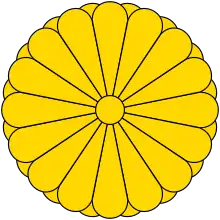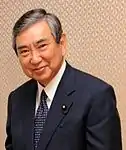1979 Japanese general election
Results of the 1979 general election in Japan for the House of Representatives. A total of 511 seats were contested. Prime Minister Ōhira Masayoshi's announcement that a consumption (sales) tax would be imposed was a hot-button issue in the run-up to the election. Facing widespread public disapproval, the prime minister abandoned the tax proposal.[1] The prime minister's party, the Liberal Democratic Party, ended up losing one seat, while the Japan Communist Party experienced a surge in voter support, which mostly came at the expense of the Japan Socialist Party and the LDP-breakaway New Liberal Club.
| Parties | Candidates | Votes[4] | % | Seats | +/- (last gen. election) | |
|---|---|---|---|---|---|---|
| Liberal Democratic Party (LDP) | 322 | 24,084,130 | 44.59% | 248 | ||
| Japanese Socialist Party (JSP) | 157 | 10,643,450 | 19.71% | 107 | ||
| Japanese Communist Party (JCP) | 128 | 5,625,527 | 10.42% | 39 | ||
| Justice Party | 64 | 5,282,682 | 9.78% | 57 | ||
| Democratic Socialist Party (DSP) | 53 | 3,663,691 | 6.78% | 35 | ||
| New Liberal Club (NLC) | 31 | 1,631,811 | 3.02% | 4 | ||
| Social Democratic Federation (SDF) | 7 | 368,660 | 0.68% | 2 | ( | |
| Center-left opposition | 155 | 10,946,847 | 20.25% | 98 | ||
| Others | 33 | 69,101 | 0.13% | 0 | ||
| Independents | 96 | 2,641,064 | 4.89% | 19 | ||
| Totals (Turnout 68.0%, incl. invalid votes) | 891 | 54,010,120 | 100.00% | 511 | ||

| |||||||||||||||||||||||||||||||||||||||||||||||||||||||||||||||||||||||||||||||||||||||||||||||||||||||||||||||||||||||
All 511 seats to the House of Representatives of Japan 256 seats needed for a majority | |||||||||||||||||||||||||||||||||||||||||||||||||||||||||||||||||||||||||||||||||||||||||||||||||||||||||||||||||||||||
|---|---|---|---|---|---|---|---|---|---|---|---|---|---|---|---|---|---|---|---|---|---|---|---|---|---|---|---|---|---|---|---|---|---|---|---|---|---|---|---|---|---|---|---|---|---|---|---|---|---|---|---|---|---|---|---|---|---|---|---|---|---|---|---|---|---|---|---|---|---|---|---|---|---|---|---|---|---|---|---|---|---|---|---|---|---|---|---|---|---|---|---|---|---|---|---|---|---|---|---|---|---|---|---|---|---|---|---|---|---|---|---|---|---|---|---|---|---|---|---|
| Turnout | 68.01% ( | ||||||||||||||||||||||||||||||||||||||||||||||||||||||||||||||||||||||||||||||||||||||||||||||||||||||||||||||||||||||
| |||||||||||||||||||||||||||||||||||||||||||||||||||||||||||||||||||||||||||||||||||||||||||||||||||||||||||||||||||||||
| |||||||||||||||||||||||||||||||||||||||||||||||||||||||||||||||||||||||||||||||||||||||||||||||||||||||||||||||||||||||
 |
|---|
| This article is part of a series on the politics and government of Japan |
|
|
References
- "The Political History of Japan's Consumption Tax". nippon.com. 2019-10-08. Retrieved 2020-03-12.
- Ministry of Internal Affairs and Communications (MIC), Statistics Department, Long-term statistics, chapter 27: Public servants and elections, sections 27-7 to 27-10 Elections for the House of Representatives
- Interparliamentary Union (IPU): 1979 and 1980 Shūgiin elections
- Decimals from fractional votes (anbunhyō) rounded to full numbers
This article is issued from Wikipedia. The text is licensed under Creative Commons - Attribution - Sharealike. Additional terms may apply for the media files.


